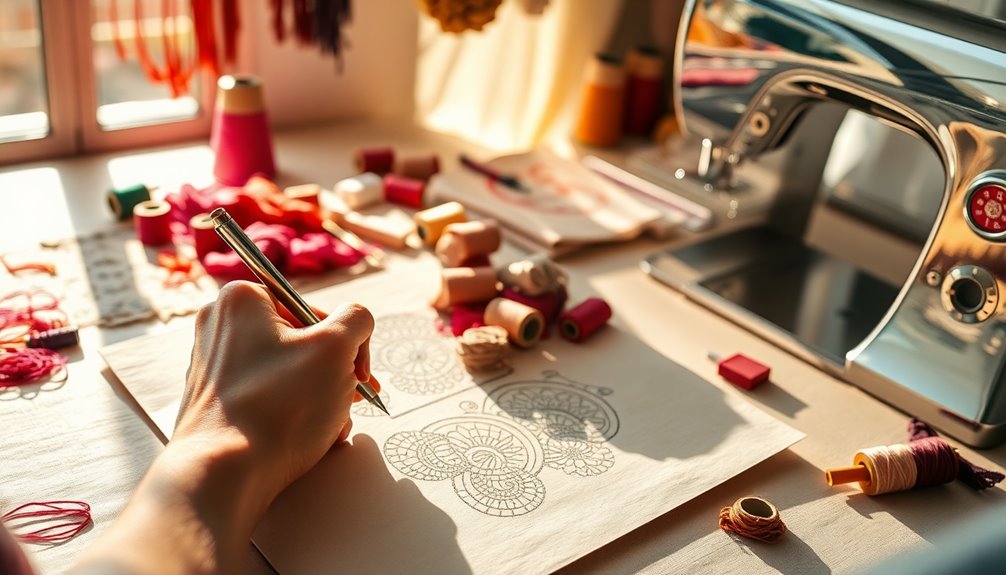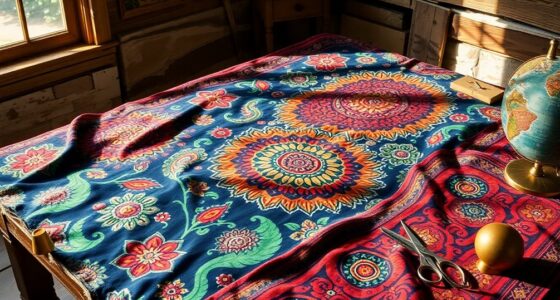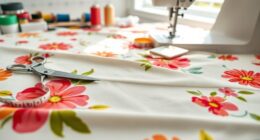Mastering pattern creation starts with transforming your sketches into precise technical drawings. You'll collaborate with skilled pattern makers to avoid miscalculations and guarantee your designs fit well. Regular fittings with seamstresses and live models will refine your garments for the perfect fit. Understanding grading and alteration techniques allows you to create sizes for everyone without losing design integrity. Keep exploring to access advanced methods that enhance your fashion design skills further.
Key Takeaways
- Transform sketches into precise technical drawings to serve as effective communication tools between designers and pattern makers.
- Utilize meticulous measurements and live model fittings to refine patterns, ensuring a perfect fit for various body shapes.
- Create muslin test garments to check fit and make necessary alterations before finalizing patterns for production.
- Engage in community workshops and online forums for hands-on learning and constructive feedback on pattern creation techniques.
- Master advanced techniques like CAD software and draping to enhance accuracy and garment movement while maintaining design integrity.
The Role of Patterns in Fashion Design
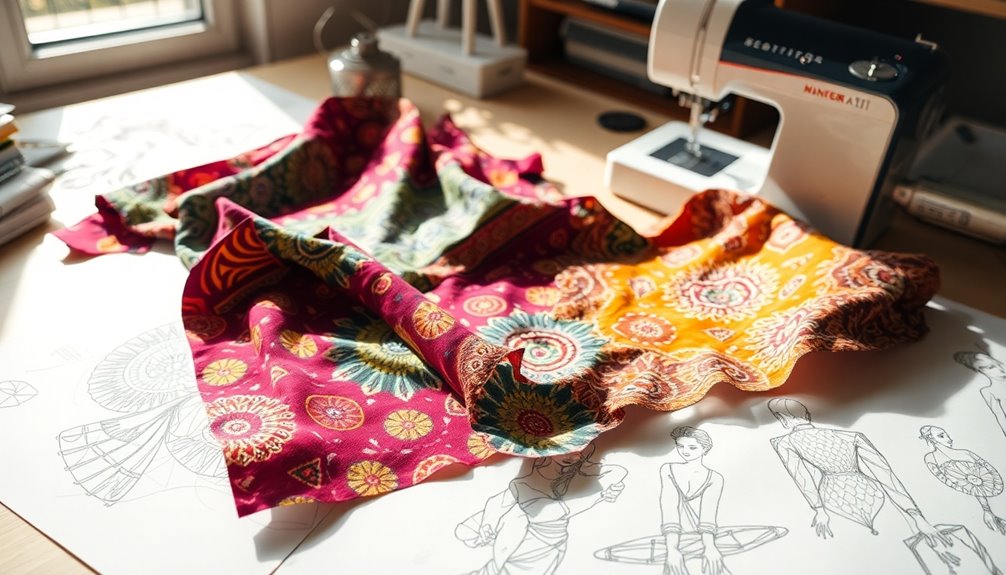
When you think about fashion design, patterns are the unsung heroes that bring a designer's vision to life. The pattern making process transforms creative sketches into precise blueprints for garment construction, ensuring a flawless fit.
Your design skills play an important role here, as collaboration with pattern makers helps capture the essence of your vision. Accuracy is essential; even a tiny miscalculation can lead to disappointing results, making meticulous measurement crucial.
Grading patterns allows you to create multiple sizes while preserving design integrity, catering to diverse body types. Additionally, the fitting process requires working closely with seamstresses and testing on live models, enabling you to refine patterns for that perfect fit, ultimately elevating your designs to new heights.
Transforming Sketches Into Technical Drawings
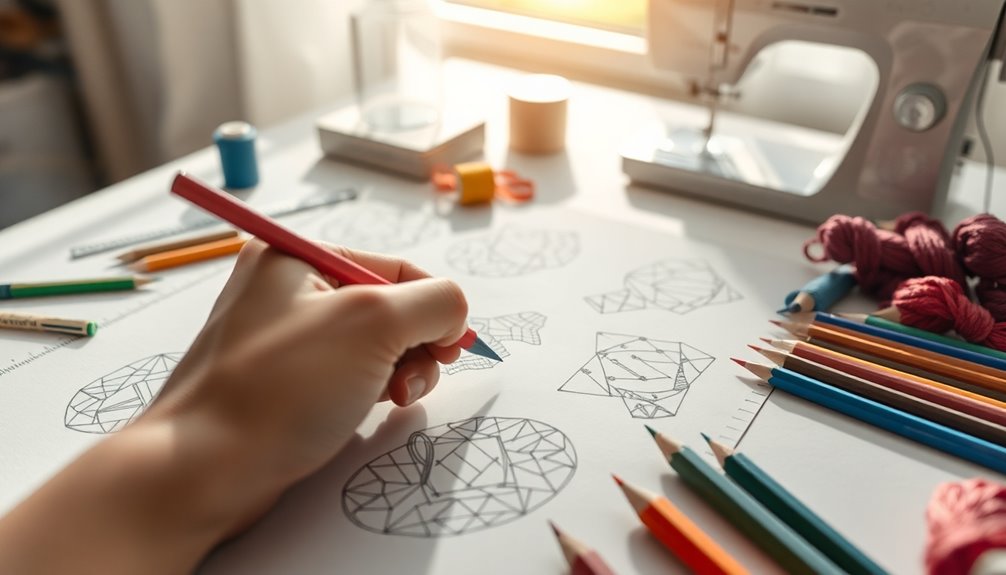
Transforming your sketches into technical drawings is essential for bringing your design ideas to life.
By focusing on precise details and accurate measurements, you guarantee that your patterns fit perfectly and reflect your vision.
Let's explore effective sketching techniques and how to convert those ideas into workable patterns.
Importance of Technical Drawings
Technical drawings play an essential role in bridging the gap between your initial sketches and the final garment. They serve as a vital communication tool between you and pattern makers, providing clear visual representations of garment features and construction details.
With precise measurements and annotations, these technical drawings guide the pattern-making process, ensuring accurate production. By transforming your sketches into detailed drawings, you can effectively convey your vision, minimizing misinterpretations during pattern making.
Additionally, accurate technical drawings streamline the grading process, allowing for consistent size adjustments while preserving the design's integrity. Ultimately, utilizing these drawings reduces errors and enhances the overall quality of the final product, making them indispensable in your garment creation journey. Furthermore, planning interior design can also benefit from the clarity that technical drawings provide, ensuring that every aspect of a project is well-documented and executed.
Sketching Techniques for Designers
With a solid foundation in technical drawings, you can elevate your design process by mastering effective sketching techniques. Focus on proportion and body measurements in your sketches to guarantee well-fitting garments. Use varied line weights and shading to convey depth and texture, enhancing your design's visual appeal. Detailed annotations will provide essential information about fabric choice and construction techniques, guaranteeing clear communication during pattern drafting. Consider using digital tools to streamline your process for easier modifications and precise scaling. Understanding the difference between flat sketches and technical drawings is vital, as the latter must include specific details like seams and stitches.
| Technique | Benefit | Application |
|---|---|---|
| Varied Line Weights | Enhances depth and texture | Use in initial sketches |
| Proportion Focus | Guarantees well-fitting designs | Base sketches on body measures |
| Detailed Annotations | Clarifies design intentions | Notes on fabric and construction |
| Digital Tools | Streamlines sketch-to-drawing | Allows for easy modifications |
| Flat vs. Technical | Guarantees accurate pattern creation | Include seams and fabric types |
Converting Ideas to Patterns
As you move from sketches to technical drawings, it's crucial to grasp garment construction principles to accurately depict design features for pattern makers. Your technical drawings must be clear and detailed, serving as effective guides.
- Include precise measurements for each pattern piece
- Add annotations for construction notes
- Utilize software or manual drafting techniques for accuracy
- Seek iterative feedback from pattern makers and seamstresses
These elements guarantee your vision is accurately interpreted.
A well-executed technical drawing not only aids in the pattern-making process but also enhances communication between you and manufacturers, reducing errors during production.
The Importance of Precision in Pattern Making
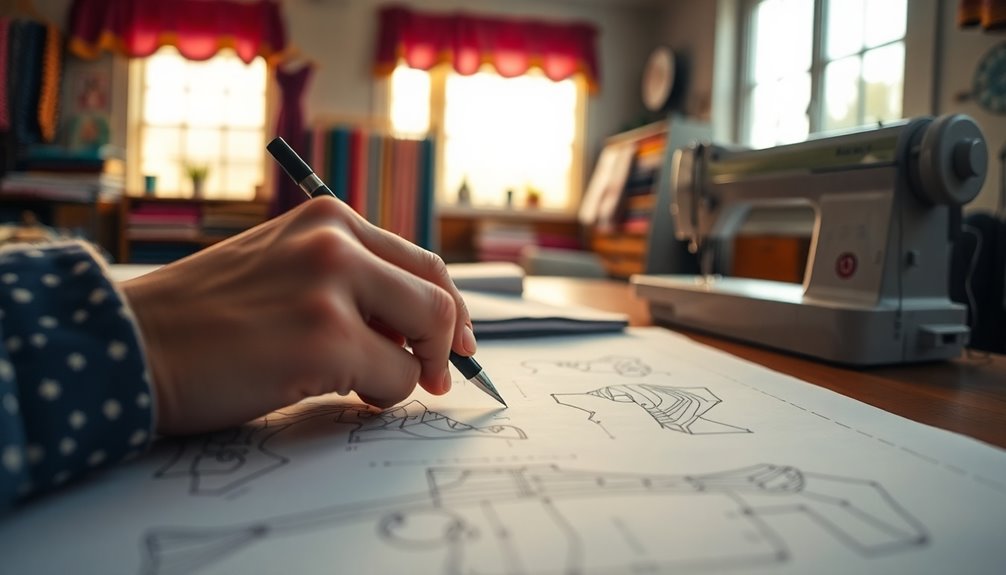
When it comes to pattern making, precision isn't just important—it's essential. As a pattern maker, every measurement you take must be meticulously calculated.
Even small miscalculations can lead to ill-fitting garments, compromising the quality and design integrity of your work. Each seam must align perfectly, creating a polished finish that enhances the garment's overall appeal.
Accurate patterns form the backbone of successful garment construction, directly impacting the fit and comfort of the final product. Additionally, collaborating closely with seamstresses during fittings allows you to make real-time adjustments, ensuring that your patterns translate effectively into well-fitting garments.
Understanding Pattern Grading for All Sizes
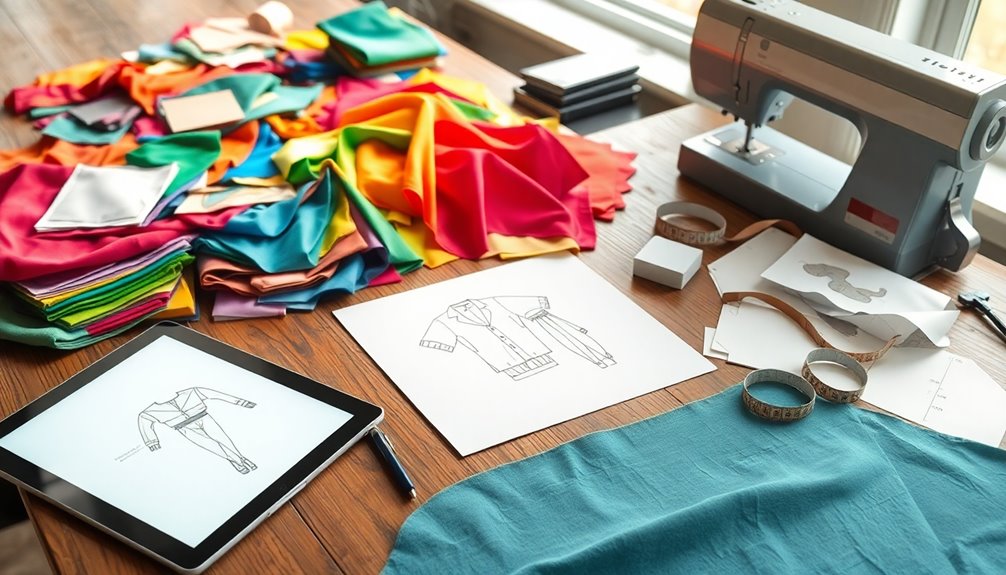
Precision in pattern making lays the groundwork for successful pattern grading, an essential skill for accommodating diverse body types.
As you engage in pattern grading, keep in mind that each size requires specific adjustments to guarantee a consistent fit.
Here's what to reflect on:
- Adjust seamlines meticulously to maintain proportional scaling.
- Create a size chart outlining exact measurements for each size.
- Contemplate the garment type and intended fit, adjusting for ease and style.
- Collaborate with seamstresses during fittings for real-world insights.
Techniques for Achieving the Perfect Fit
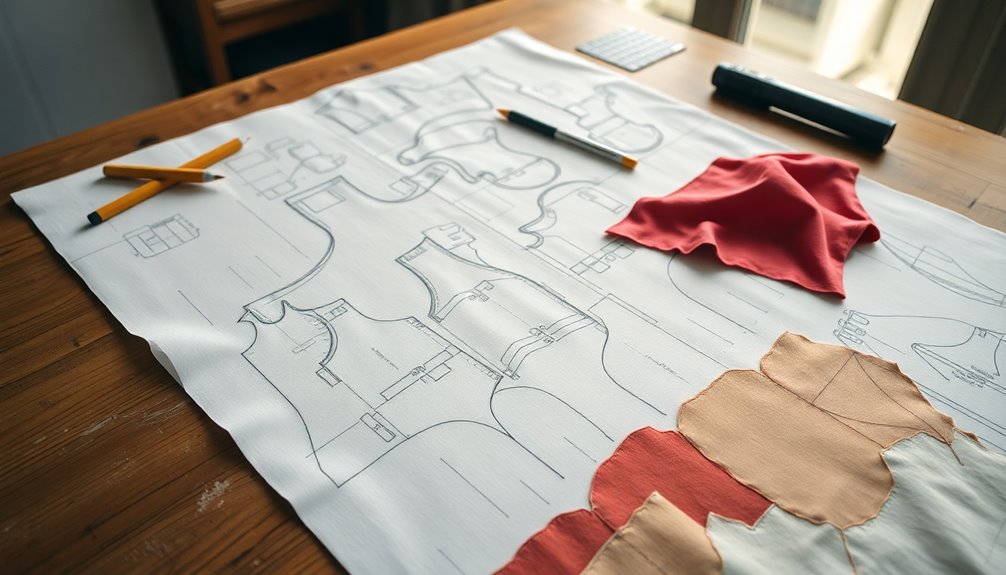
Achieving the perfect fit is essential for any garment, and there are several techniques you can employ to guarantee success.
Start with meticulous measurements taken from the body or dress forms to create initial pattern blocks. During the fitting process, live model fittings help you refine patterns based on real-time adjustments, enhancing the garment's natural shape.
Don't skip using muslin for test garments; it allows you to check the fit and make necessary alterations before final production.
Mastering pattern alterations is critical for customizing fits on unique body shapes, which often involves adjusting seamlines, darts, and overall dimensions.
The Process of Drafting Patterns
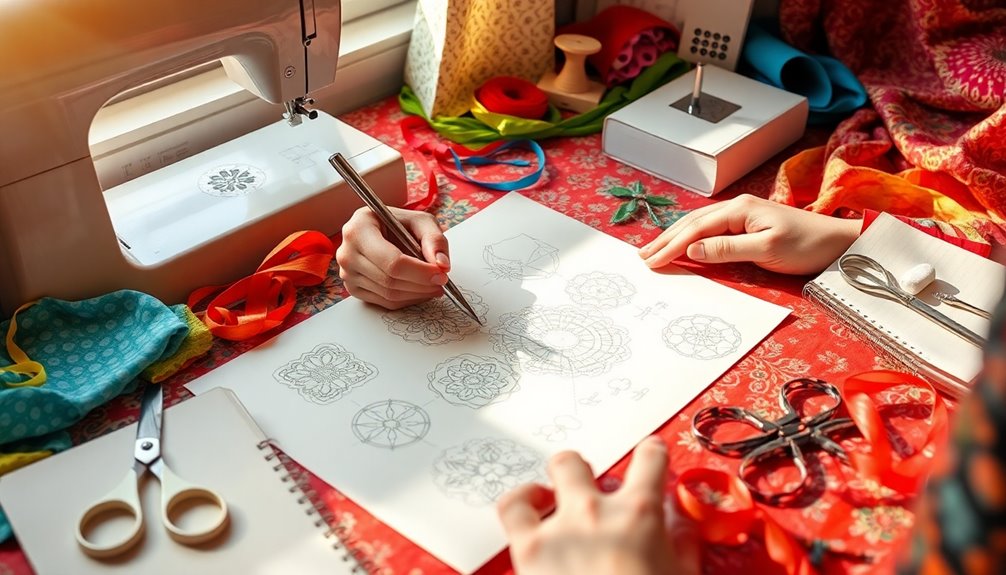
Drafting patterns is an essential step in bringing your garment ideas to life. This process begins with creating basic blocks based on accurate body measurements or dress forms.
You'll need to focus on:
- Designing front and back bodice patterns
- Incorporating precise measurements for sleeves
- Considering seam allowances and ease
- Testing fit with a muslin prototype
As you transform your sketches into technical patterns, you'll use problem-solving skills and mathematical computation to guarantee everything aligns.
Redrafting may be necessary to achieve that perfect fit. By carefully testing your prototypes, you can make adjustments before finalizing the pattern for production.
With practice, you'll master the art of drafting patterns and create garments that fit beautifully.
Resources for Learning Pattern Making
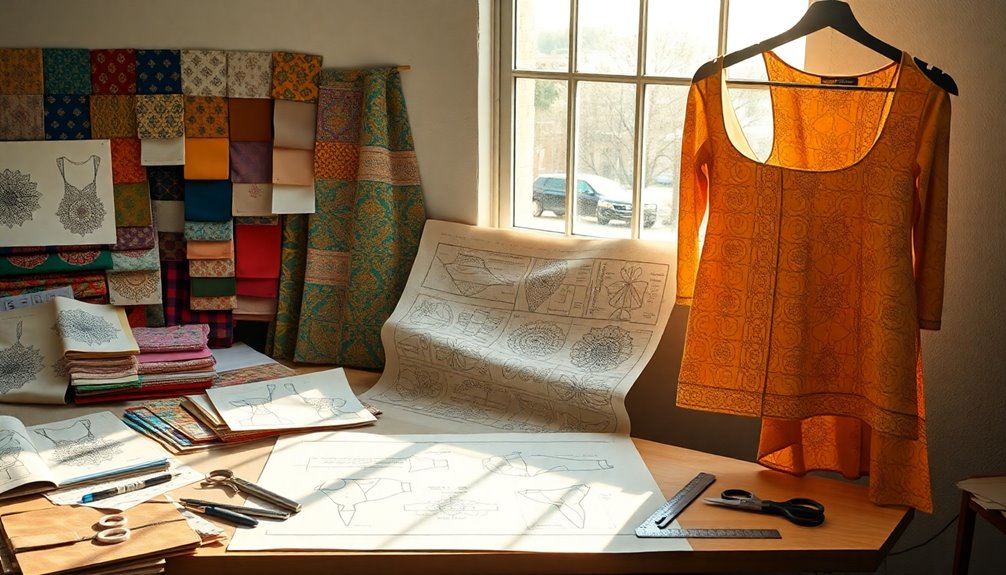
When you're ready to enhance your pattern-making skills, recommended books like "Patternmaking for Fashion Design" can guide you through essential techniques.
Online learning platforms also offer valuable courses tailored to various skill levels, helping you grow your expertise.
Exploring these resources will set you on the right path to mastering pattern creation.
Recommended Pattern Books
Five essential pattern books can elevate your skills in pattern making, whether you're just starting or looking to refine your techniques.
These resources provide vital insights into the world of pattern design, helping you master the art of creating and altering patterns.
- "Patternmaking for Fashion Design" by Helen Joseph Armstrong – Thorough techniques for all skill levels.
- "The Practical Guide to Patternmaking for Fashion Design" by Lori Knowles – Step-by-step instructions with clear illustrations.
- "Patternmaking Made Easy" by Connie Crawford – User-friendly methods for custom fits.
- "Pattern Fitting and Alteration" by Elizabeth Liechty and Judith Rasband – Techniques to adjust patterns for unique body shapes.
Investing in these books will support your journey in mastering pattern creation and achieving the perfect fit.
Online Learning Platforms
Building on the foundational knowledge gained from recommended pattern books, online learning platforms offer a modern approach to mastering pattern making.
Courses like the Fair Fit Method cover essential topics, including fashion draping and pattern alteration, allowing you to refine the pattern effectively. With video tutorials and detailed instructions, you can grasp complex concepts at your own pace, reinforcing skills through hands-on projects that include managing seam allowances.
Interactive webinars, such as "Sketch to Stitch," let you engage with experienced instructors for immediate feedback. Community forums encourage collaboration, where you can share experiences and seek advice from peers and experts.
These resources enhance your understanding of mathematical guidelines and measurement techniques, making your pattern-making journey more thorough and enjoyable. Additionally, best knitting patterns provide inspiration for your designs, helping you to visualize how your patterns can come to life in various projects.
Community Engagement in Pattern Creation
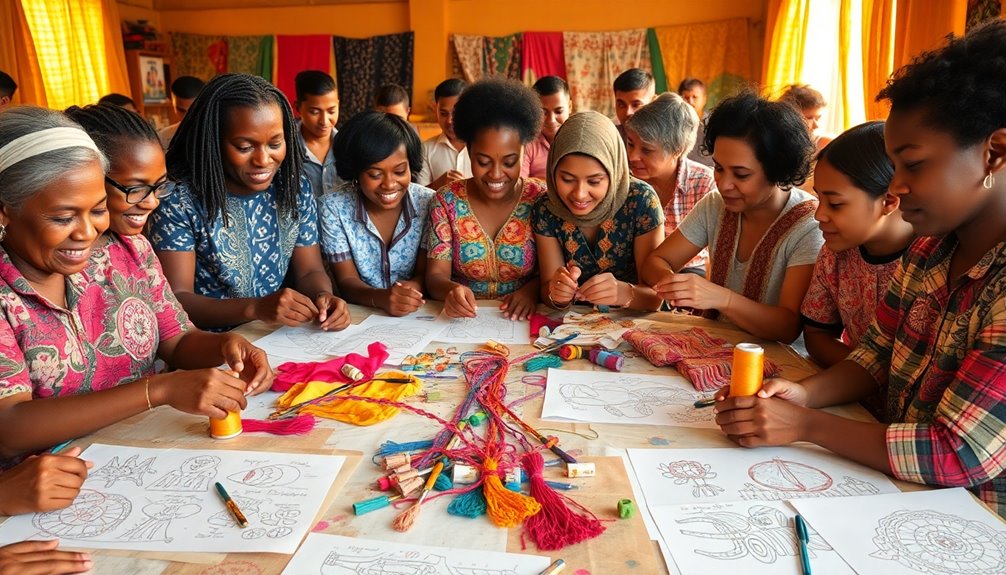
Engaging with a community of fellow pattern makers can transform your learning experience, offering invaluable feedback and inspiration.
When you immerse yourself in community engagement, you'll notice how it enhances your creative process and skill development.
Here are some ways to connect:
- Participate in online forums and social media groups tailored for pattern makers.
- Join workshops and webinars, like those from Fair Fit Studio, for hands-on learning.
- Seek out local sewing clubs or classes for practical guidance and mentorship.
- Share your completed projects and muslin fittings to encourage constructive critiques.
Exploring Advanced Pattern Making Techniques
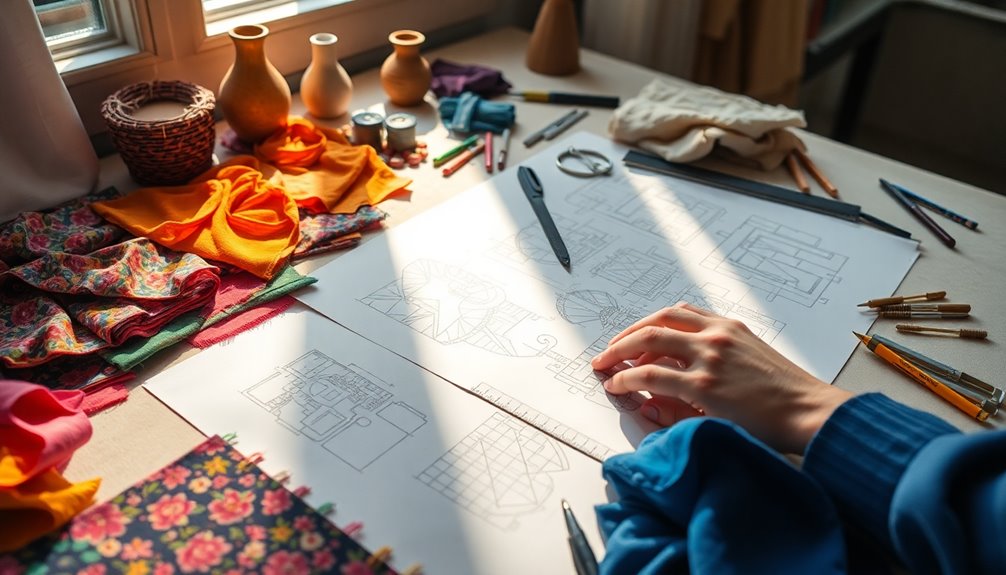
As you explore advanced pattern making techniques, you'll discover how tools like computer-aided design (CAD) software can revolutionize your drafting process. These techniques enhance accuracy and efficiency throughout the construction process.
| Technique | Purpose | Benefits |
|---|---|---|
| CAD Software | Create precise digital patterns | Improved accuracy |
| Draping Techniques | Understand fabric behavior on the body | Better fit and movement |
| Grading Process | Resize patterns while maintaining design integrity | Consistent sizing |
| Advanced Alterations | Tailor patterns through fitting adjustments | Customized fit |
Mastering these skills, including advanced alterations, guarantees your garments fit well and look polished. Embrace these techniques to elevate your pattern making to the next level!
Frequently Asked Questions
What Are the Four Steps in a Drafting Pattern?
To draft a pattern, you start by taking accurate body measurements or using standard size charts to create basic blocks.
Next, sketch your design ideas and translate them into technical drawings.
Then, manipulate those basic blocks to draft the actual pattern pieces, adding seamlines and style details while ensuring a good fit.
Finally, create a muslin prototype to test the fit, making adjustments before grading the pattern for various sizes.
How to Become a Sewing Pattern Designer?
So, you wanna be a sewing pattern designer? Well, grab your measuring tape and prepare for the glamorous life of fabric and scissors!
First, learn the basics of sewing—it's not just about looking cute in your creations. Immerse yourself in courses on drafting and grading; they're not just for show.
Get comfy with body measurements, and don't shy away from studying existing patterns. Trust me, it'll all pay off when you're cutting your unique designs!
What Are the Steps in Developing a Production Pattern?
To develop a production pattern, start by creating a basic block using accurate body measurements.
Once you've got that, modify the block to add your design elements like style lines and seam placements.
Next, sew a muslin or test garment to check the fit and make adjustments as needed.
After finalizing the pattern, grade it to create different sizes, then digitize or trace it onto pattern paper for precise cutting.
What Is the Art of Making Pattern?
The art of making patterns isn't just about lines and shapes; it's about precision and creativity.
You're transforming sketches into templates that guide the entire garment-making process. Each measurement you take affects the final fit, so attention to detail is essential.
You'll draft basic blocks and refine them through fittings, ensuring every piece captures the designer's vision while being functional.
It's a blend of artistry and technical skill that makes fashion come alive.
Conclusion
In the garden of fashion, patterns are the seeds that bloom into stunning creations. As you nurture your skills from sketch to stitch, remember that each line and curve is a pathway to your vision. With precision as your sunlight and techniques as your water, you’ll cultivate pieces that fit like a second skin. Embrace the community around you, for together, you’ll harvest a bounty of creativity that transforms dreams into wearable art. Keep sowing and stitching! As you explore new ideas and refine your techniques, you might find yourself wondering how to organize sewing patterns to streamline your creative process. A well-structured system will not only save you time but also inspire fresh designs as you sift through your curated collection. Remember, just like in gardening, a little organization can go a long way in helping your fashion aspirations flourish. Keep nurturing your creativity, and watch as your unique style takes root and blossoms!
